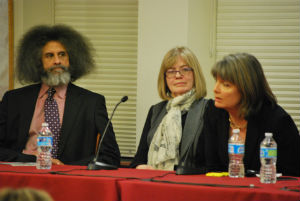Prof. Jody Armour discusses the role of sketch artists in the courtroom
-By Jared Servantez
Three of the country’s most prominent courtroom artists shared their stories and experiences before a packed crowd at the USC Visions and Voices event, “Art in the Court: Famous Trials Illustrated,” held recently at Doheny Memorial Library.
Annenberg School for Communication and Journalism Professor Judy Muller moderated the discussion with the artists Elizabeth Williams, Bill Robles and Aggie Kenny, as well as Gould School of Law Professor Jody Armour.
The sketch artists discussed what it is like to cover such high-profile trials as Charles Manson, O.J. Simpson, Michael Jackson and Jerry Sandusky.
 |
| Professor Jody Armour speaks with courtroom artists Aggie Kenny and Elizabeth Williams. |
With cameras still banned inside many courtrooms across the country, including the U.S. Supreme Court, sketch artists often provide the only opportunity for the public to see inside the courtroom.
The sketch artists shared how their work lies at that intersection of journalism and art, and how they strike a balance between artistic style and representing a scene as accurately as possible.
“It’s hard to do,” Williams said. “You’re supposed to render that scene the way it exists. You’re not supposed to change anything; you’re not supposed to move anything around. Journalism is facts, and you’re supposed to be as factual as you can with your artwork.”
Armour explained reasons why the courts often allow sketch artists, but no cameras. “It’s the dignity of the court,” he said. “We’re back to the court wanting to control a certain moral credibility, a certain moral authority, and they think that they can enhance that if they do a lot of stagecraft and control information sources and make sure they look a certain way. It’s a little fascistic really, I’m afraid.”
Each of the artists shared specific examples of their work to illustrate different points about their profession. Kenny showed a sketch of James Earl Ray, who was convicted in 1969 of assassinating Martin Luther King, Jr. She depicted him just as she saw him in the courtroom, and the result was what Muller called “a very nice portrait” if you didn’t know who the subject was and what he had done.
 |
| Aggie Kenny’s sketch of the Supreme Court of the United States. |
“It was interesting for me to see this very small, disheveled country boy, and just almost impossible to think that he was capable of such a heinous crime,” Kenny said. “To me, that’s what he looked like, and that was the paradox.”
Armour said the discussion with the three artists highlighted the relationship between art, law and journalism.
“There’s the art of discourse and the art of persuasion that are at the heart of law, and those are creative arts,” Armour said. “You don’t just find the truth in law. To a large extent it’s a very creative enterprise. We create outcomes, we tell stories, we create narratives, and all those narratives require artistic sensibilities. To be a great lawyer, you’ve got to be a great artist in a sense to tell good stories that are compelling.”

















